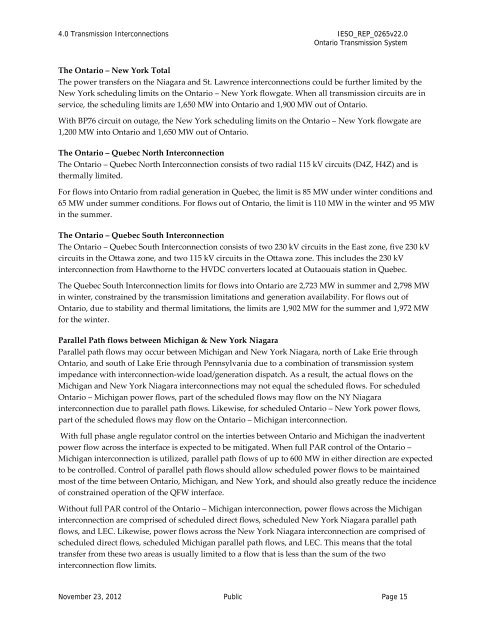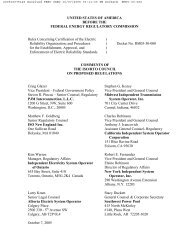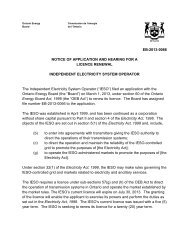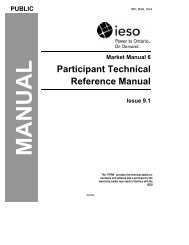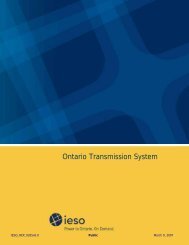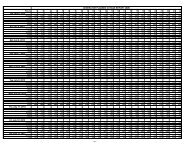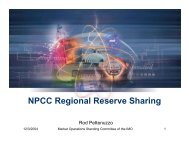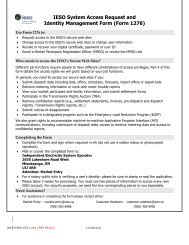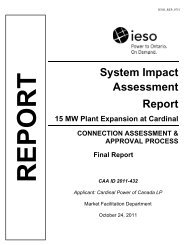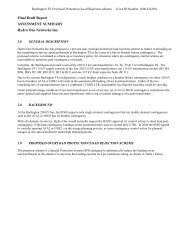Ontario Transmission System - November 2012 - IESO
Ontario Transmission System - November 2012 - IESO
Ontario Transmission System - November 2012 - IESO
You also want an ePaper? Increase the reach of your titles
YUMPU automatically turns print PDFs into web optimized ePapers that Google loves.
4.0 <strong>Transmission</strong> Interconnections <strong>IESO</strong>_REP_0265v22.0<br />
<strong>Ontario</strong> <strong>Transmission</strong> <strong>System</strong><br />
The <strong>Ontario</strong> – New York Total<br />
The power transfers on the Niagara and St. Lawrence interconnections could be further limited by the<br />
New York scheduling limits on the <strong>Ontario</strong> – New York flowgate. When all transmission circuits are in<br />
service, the scheduling limits are 1,650 MW into <strong>Ontario</strong> and 1,900 MW out of <strong>Ontario</strong>.<br />
With BP76 circuit on outage, the New York scheduling limits on the <strong>Ontario</strong> – New York flowgate are<br />
1,200 MW into <strong>Ontario</strong> and 1,650 MW out of <strong>Ontario</strong>.<br />
The <strong>Ontario</strong> – Quebec North Interconnection<br />
The <strong>Ontario</strong> – Quebec North Interconnection consists of two radial 115 kV circuits (D4Z, H4Z) and is<br />
thermally limited.<br />
For flows into <strong>Ontario</strong> from radial generation in Quebec, the limit is 85 MW under winter conditions and<br />
65 MW under summer conditions. For flows out of <strong>Ontario</strong>, the limit is 110 MW in the winter and 95 MW<br />
in the summer.<br />
The <strong>Ontario</strong> – Quebec South Interconnection<br />
The <strong>Ontario</strong> – Quebec South Interconnection consists of two 230 kV circuits in the East zone, five 230 kV<br />
circuits in the Ottawa zone, and two 115 kV circuits in the Ottawa zone. This includes the 230 kV<br />
interconnection from Hawthorne to the HVDC converters located at Outaouais station in Quebec.<br />
The Quebec South Interconnection limits for flows into <strong>Ontario</strong> are 2,723 MW in summer and 2,798 MW<br />
in winter, constrained by the transmission limitations and generation availability. For flows out of<br />
<strong>Ontario</strong>, due to stability and thermal limitations, the limits are 1,902 MW for the summer and 1,972 MW<br />
for the winter.<br />
Parallel Path flows between Michigan & New York Niagara<br />
Parallel path flows may occur between Michigan and New York Niagara, north of Lake Erie through<br />
<strong>Ontario</strong>, and south of Lake Erie through Pennsylvania due to a combination of transmission system<br />
impedance with interconnection-wide load/generation dispatch. As a result, the actual flows on the<br />
Michigan and New York Niagara interconnections may not equal the scheduled flows. For scheduled<br />
<strong>Ontario</strong> – Michigan power flows, part of the scheduled flows may flow on the NY Niagara<br />
interconnection due to parallel path flows. Likewise, for scheduled <strong>Ontario</strong> – New York power flows,<br />
part of the scheduled flows may flow on the <strong>Ontario</strong> – Michigan interconnection.<br />
With full phase angle regulator control on the interties between <strong>Ontario</strong> and Michigan the inadvertent<br />
power flow across the interface is expected to be mitigated. When full PAR control of the <strong>Ontario</strong> –<br />
Michigan interconnection is utilized, parallel path flows of up to 600 MW in either direction are expected<br />
to be controlled. Control of parallel path flows should allow scheduled power flows to be maintained<br />
most of the time between <strong>Ontario</strong>, Michigan, and New York, and should also greatly reduce the incidence<br />
of constrained operation of the QFW interface.<br />
Without full PAR control of the <strong>Ontario</strong> – Michigan interconnection, power flows across the Michigan<br />
interconnection are comprised of scheduled direct flows, scheduled New York Niagara parallel path<br />
flows, and LEC. Likewise, power flows across the New York Niagara interconnection are comprised of<br />
scheduled direct flows, scheduled Michigan parallel path flows, and LEC. This means that the total<br />
transfer from these two areas is usually limited to a flow that is less than the sum of the two<br />
interconnection flow limits.<br />
<strong>November</strong> 23, <strong>2012</strong> Public Page 15


